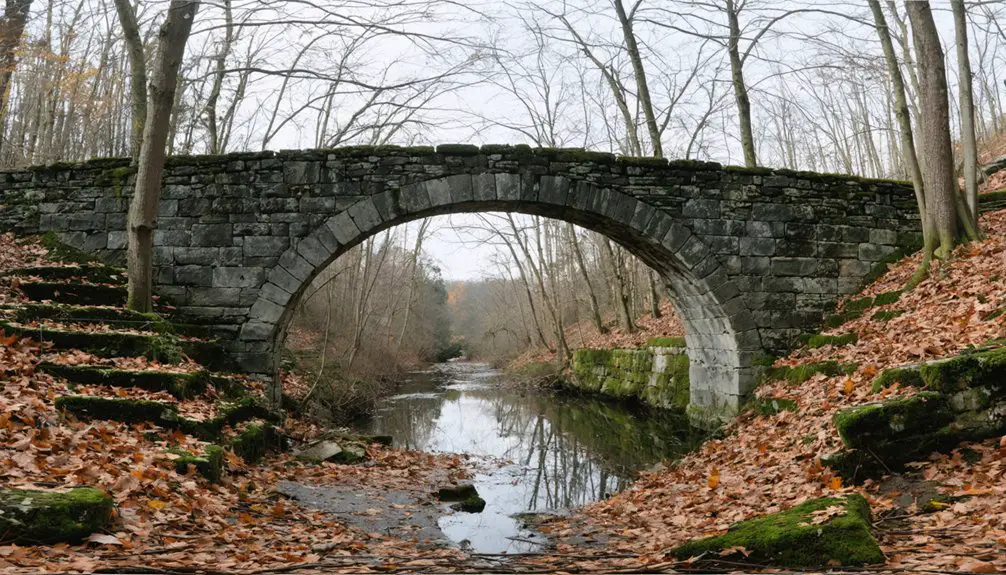You’ll discover Aqueduct, Pennsylvania’s remarkable ghost town, anchored by a pristine stone bridge from 1879. This masterpiece of mortar-free construction, built by Sicilian craftsmen, stands as the last remnant of William Vanderbilt’s abandoned South Pennsylvania Railroad project. The bridge’s precise stonework has survived 140 years without modern adhesives, defying time in the rural landscape. Beyond the bridge’s striking architecture lies a complex tale of industrial ambition, skilled craftsmanship, and economic transformation.
Key Takeaways
- Aqueduct was a Pennsylvania railroad settlement that became abandoned after the South Pennsylvania Railroad project was halted in the 1880s.
- The site features remarkably preserved stone masonry structures built by Sicilian craftsmen using mortar-free construction techniques.
- The ghost town’s decline was directly linked to Pennsylvania’s shifting coal transportation routes and railroad company competition.
- Urban explorers frequently document the site’s abandoned infrastructure, including its signature aqueduct structure built nearly 140 years ago.
- The settlement represents the ambitious but unrealized vision of railroad magnate William Vanderbilt, who invested over $10 million in the project.
The Lost Vision of South Penn Railroad
While the South Pennsylvania Railroad began modestly as the Duncannon, Landisburg, and Broad Top Railroad Company in 1854, it evolved into an ambitious venture that sought to connect Marysville to West Newton across 200 miles of challenging Pennsylvania terrain.
You’ll find the failed ambitions of this project reflected in its multiple name changes and limited construction – only two miles of grading were completed before 1879.
When railroad titan William Henry Vanderbilt acquired the charter, he released 300 engineers and thousands of laborers to challenge the Pennsylvania Railroad’s dominance. The project was abandoned after two years’ construction and over $10 million spent.
The southern route required the construction of nine major tunnels through the mountain ridges.
The historical significance of this unrealized dream lives on through remarkable structures like the mortar-free aqueduct near Sideling Hill Tunnel, built by Sicilian craftsmen.
Sicilian artisans left their mark on Pennsylvania’s landscape through the masterful mortar-free aqueduct, a testament to unrealized railroad ambitions.
Though the railroad never materialized, its legacy shaped Pennsylvania’s transportation future.
Architectural Marvel: A Mortar-Free Masterpiece
You’ll find an extraordinary example of Sicilian stone masonry skill in this abandoned Pennsylvania aqueduct, where master craftsmen fitted each stone precisely without using any mortar or modern adhesives.
The engineering prowess demonstrated in this 140-year-old structure relied entirely on the perfect cutting and interlocking of locally sourced stones, with weight and friction maintaining its stability.
Despite decades of abandonment, the mortar-free construction technique has proven remarkably effective, as the aqueduct stands nearly pristine today, showcasing the enduring legacy of 19th-century Italian craftsmanship in American railroad infrastructure. Originally commissioned by William Vanderbilt’s railroad, this architectural marvel demonstrates the ambitious vision behind the South Pennsylvania Railroad project. Like the nearby Fricks Locks Historic District, the structure stands as a testament to Pennsylvania’s rich transportation heritage.
Sicilian Stone Masonry Legacy
In the heart of Pennsylvania’s abandoned town of Aqueduct stands a remarkable tribute to Sicilian craftsmanship – the South Penn Railroad Aqueduct of 1883.
You’ll find a masterpiece of engineering that showcases the precision and skill of immigrant stone masons who transformed local stone into an enduring monument without using a drop of mortar.
These craftsmen brought centuries-old Mediterranean techniques to American soil, meticulously cutting and shaping each stone to create perfect fits.
Their expertise in stone fitting produced an infrastructure marvel that’s withstood nearly 140 years of Pennsylvania’s harsh weather.
The aqueduct’s tight, interlocking stones work with gravity and friction to maintain structural integrity, while its visible joints reveal the artisanal quality of traditional Sicilian masonry methods.
This lasting achievement proves that old-world craftsmanship could meet modern industrial demands. The structure’s impressive 15-foot tall barrel allows ample clearance for water flow and passage.
The innovative use of wire-rope suspension techniques revolutionized aqueduct construction in the region, setting new standards for engineering excellence.
Engineering Without Modern Adhesives
Through ingenious engineering principles, the South Penn Railroad Aqueduct stands as a tribute to mortar-free construction mastery.
Like many structures in Pennsylvania’s coal mining region, the aqueduct faced intense industrial demands during the state’s peak production years.
Like the historic stone arch bridge of 1818, the structure demonstrates the incredible durability of well-executed arch construction.
You’ll find remarkable engineering techniques at work here – precisely cut stones interlock through gravity and friction alone, while sophisticated arch designs convert vertical forces into compressive strength along the joints.
The structure’s resilience stems from its flexible nature. Without mortar, the aqueduct can adapt to ground settling and seismic activity, while avoiding the freeze-thaw damage that typically deteriorates mortared joints.
The evidence is in its longevity: after nearly 140 years, the structure remains impressively intact. Every stone was carefully selected and shaped to create tight, self-supporting fits that distribute loads effectively.
It’s a demonstration of how structural resilience doesn’t always require modern adhesives.
Enduring Through Time Tests
While many historic structures succumb to time’s ravages, the South Penn Railroad Aqueduct stands as an architectural marvel of endurance.
You’ll find its timeless resilience demonstrated through 140 years of withstanding Pennsylvania’s harsh climate, including punishing freeze-thaw cycles that typically destroy similar structures.
What’s remarkable is how this masterpiece has defied natural elements without traditional mortar.
The Sicilian stonemasons’ precise cutting and placement techniques created a self-sustaining structure that’s virtually maintenance-free. They engineered each stone to lock perfectly with its neighbors, using gravity and friction to maintain stability. Much like the Tudor-style architecture of the old Cresson State Prison, this construction method represents a pinnacle of historical building practices.
The aqueduct’s condition today mirrors its original state, showing minimal wear despite decades of exposure to weather, floods, and forest growth.
It’s a reflection of the superior craftsmanship of 19th-century engineering.
Legacy of Sicilian Stone Masonry
How did ancient Sicily’s masonry traditions shape architectural history? You’ll find the answer in sophisticated Sicilian techniques that blended indigenous knowledge with Greek colonial influences.
Ancient craftsmanship at sites like Cave di Cusa demonstrates remarkable expertise in quarrying and shaping tufa limestone for monumental construction. This included lime mortar mixtures following the meticulous guidelines of three parts sand to one part lime for optimal durability.
You can trace this mastery through their varied approaches: from cyclopean walls built without mortar to precisely cut ashlar blocks laid in perfect courses.
At Cave di Cusa, abandoned blocks still reveal tool marks and cutting methods from 409 BC, while diatoni blocks in fortifications show ingenious material conservation.
The legacy lives on in their innovative use of hydraulic mortars enhanced with natural additives, and their understanding of compression mechanics in dry stone construction – techniques that would influence architecture for centuries to come.
Ghost Town Chronicles and Urban Exploration

As urban explorers venture into Aqueduct, Pennsylvania, they’ll discover a haunting monument to America’s industrial decline. Through their camera lenses, they’re documenting crumbling stone foundations, abandoned railroad beds, and derelict infrastructure that nature slowly reclaims.
The town’s growing popularity on social media has attracted more adventurers seeking to capture its urban decay aesthetics. While exploration ethics demand respect for the site’s historical significance, you’ll need to exercise extreme caution due to unstable structures and industrial contamination.
The remnants you’ll encounter tell a broader story of the Rust Belt’s transformation, where once-thriving coal and coke operations gave way to ghost towns. Through digital platforms and photography, urban explorers are preserving Aqueduct’s legacy before time erases these essential traces of industrial heritage.
Pennsylvania’s Industrial Transformation
You’ll find that Pennsylvania’s coal industry shaped Aqueduct’s fate during the late 1800s, as anthracite mining operations dominated the region’s economy and transformed rural communities into bustling industrial centers.
The arrival of competing railroad companies in the area, particularly the Pennsylvania Railroad and Reading Railroad, intensified the development of coal transportation infrastructure throughout the state.
These rail networks created a complex web of commercial rivalries that ultimately determined which mining towns would thrive and which, like Aqueduct, would fade into obscurity.
Coal’s Economic Dominance
Pennsylvania’s transformation into an industrial powerhouse began with the rise of bituminous coal mining in the late 1700s near Pittsburgh’s “Coal Hill.”
The region’s daily coal consumption reached 400 tons by 1830, fueling both domestic needs and industrial growth.
Railroad Competition Evolution
The rise of coal mining in western Pennsylvania sparked a fierce railroad competition that would reshape the state’s industrial landscape. You’d find the Pennsylvania Railroad leading the charge, strategically building routes through river valleys from Harrisburg to Pittsburgh by 1852.
The railroad rivalry intensified as the Baltimore & Ohio, Erie Railroad, and New York Central fought for dominance in Mid-Atlantic markets.
This freight competition drove remarkable innovations. The PRR pioneered steel rails in 1865, while track pans at Sang Hollow let locomotives refuel without stopping.
You’ll see how the railroads’ aggressive expansion shaped the region, with the PRR securing key routes to Cincinnati and St. Louis by 1870. Through strategic mergers and acquisitions, they’d establish an industrial network that connected Philadelphia’s ports to the resource-rich western territories.
Preserving History Through Documentation

While many ghost towns fade into obscurity, dedicated efforts to document Aqueduct’s history have preserved essential details about this abandoned Pennsylvania railroad settlement.
Through various documentation techniques, you’ll find extensive records of the South Penn Railroad Aqueduct near Sideling Hill Tunnel, built by skilled Sicilian stone masons in the late 1800s.
Historical preservation efforts have focused on capturing the site through photographs, videos, and detailed surveys before further deterioration occurs.
You can trace the ambitious vision of railroad titans William Vanderbilt and Andrew Carnegie through surviving documentation of their planned nine-tunnel route.
The remarkably well-preserved stonework, constructed without mortar, stands as evidence to the craftsmanship and industrial aspirations of the 19th century, even though the railroad never materialized.
Frequently Asked Questions
How Can Visitors Safely Access the Aqueduct Site Today?
You’ll find safe access via multiple Ghost Town Trail trailheads. Follow visitor guidelines by using designated parking at Dilltown, Wehrum, or Vintondale. Take safety precautions and stick to marked paths.
Are There Any Local Guides Offering Tours of the Ghost Town?
Verily, you won’t find organized local tours, though historical societies occasionally host special events. You’re free to explore independently or connect with railroad enthusiasts who share ghost stories through regional Facebook groups.
What Wildlife Species Now Inhabit the Abandoned Aqueduct and Surrounding Area?
You’ll find diverse wildlife thriving in the aqueduct’s habitat restoration zones – from white-tailed deer and raccoons to songbirds, woodpeckers, salamanders, and native trout, all contributing to local wildlife conservation efforts.
When Was the Last Known Resident Documented in This Ghost Town?
Ever wonder what became of Aqueduct’s final soul? You won’t find exact records, as ghost stories blur with fact, but unlike nearby Centralia’s documented last residents, Aqueduct’s final inhabitant remains historically unconfirmed.
Does the Property Have Current Ownership or Fall Under Government Jurisdiction?
You’ll find that all property in Aqueduct falls under Pennsylvania government jurisdiction now – there’s no private ownership since the state’s acquisition through eminent domain and property control measures.
References
- https://pabucketlist.com/exploring-the-abandoned-south-penn-railroad-aqueduct-in-fulton-county/
- https://en.wikipedia.org/wiki/Fricks_Locks_Historic_District
- https://en.wikipedia.org/wiki/List_of_ghost_towns_in_Pennsylvania
- https://www.youtube.com/watch?v=ONtJ-QTcMWo
- https://www.youtube.com/watch?v=I9TqAJjZ-UI
- https://en.wikipedia.org/wiki/South_Pennsylvania_Railroad
- https://time.com/archive/6864898/transport-dream-drained/
- http://sopennrr.tripod.com
- https://en.wikipedia.org/wiki/Southwest_Pennsylvania_Railroad
- https://pabucketlist.com/abandoned-places-in-pa-you-can-legally-explore/



